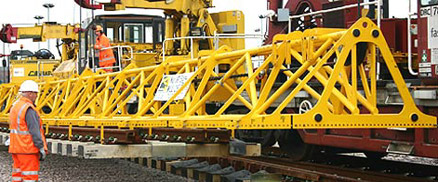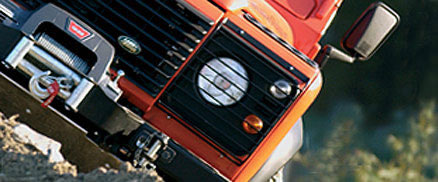November 27th, 2010
Safe Use of Blocks
The basic objectives of any lifting operation are to move the load to the desired location and land it safely, efficiently and without damage to the load, the equipment used or the surrounding buildings, plant etc. In addition to any specific instructions relating to the block the following general points must be observed:
- Never attempt lifting operations unless you have been trained
- in the use of the equipment and slinging procedures.
- Position the hook directly over the centre of gravity so that the line of pull is vertical.
- Do not use the chain/wire rope to sling the load, ie do not wrap it round the load, back hook or choke hitch.
- Do not lift on the point of the hook or overcrowd the hook with fittings.
- Never lift/lower more than the marked SWL. In the case of manual equipment if abnormally high effort is required, and with power operated appliances they fail to lift the load, or if the load slips this is an indication of too high a load or a fault – check the load and the appliance.
- Avoid unnecessary inching of power operated appliances and do not impose sudden or shock loads.
- Push rather than pull loads suspended from appliances with push/pull trolleys and if un-laden pull on the bottom hook.
- Never pull an appliance by the pendant control, supply cable or hose.
- Avoid sudden movement of travel motion or undue effort in pushing the load which can cause the load to swing.
- Avoid excessive or intentional use of motion limits unless they are additional limits intended for that purpose. Avoid running appliances against end stops.
- Do not allow anyone to pass under or ride upon the load. Never leave suspended loads unattended unless in an emergency then ensure the area is cordoned off and kept clear.
- Do not remove guards, protective covers, weather proof overs, heat shields etc without the authority of a Competent Person
Following the points above will enable the safe transportation of heavy loads including beams.
Posted in Arbil Rail |
October 23rd, 2010
Tangye’s hydraulic jacks are in daily use throughout the world working efficiently for customers who require jacks for a variety of applications from supporting bridges to lifting the nose end of F16 fighter planes.
Tangye jacks are used by the following industries – construction, industrial, automotive, mining, railroad and manufacturing.
All Tangye Hydraulic Jacks are built with the following characteristics:
Portable
Extensive use of high strength aluminium alloys has minimised jack weight for improved portability.
Reliability
All moving parts are totally enclosed and lubricated by the hydraulic oil. Seats are highly resistant to deterioration under widely varying climatic conditions. Their long working life make Hydralite jacks the choice of many rental operations.
Safe – Overload Protection
A high pressure relief valve prevents lifting of loads in excess of the jack’s capacity while locking overloads applied to the ram
Overstroke Protection
Hydralite jacks are fitted with a fail-safe positive stop mechanism which prevents overstroking of the ram by venting oil to the reservoir when the stroke limit is reached.
Load Sustaining
Jack models incorporating a threaded ram and load retaining ring, model – SR, should be selected when loads are to be sustained for a significant time. No need to rely on hydraulic fluid pressure.
Quality Assurance
Every jack is serial numbered, fully tested and certified.
Posted in Arbil Rail |
October 3rd, 2010
Lifting beams, frames and spreaders are usually designed and built
for a specific purpose. The range of designs and capacities is therefore only limited by practicality. When selecting the beam to be used you need to plan the lift taking the following into account:
Application requirements:
- to reduce headroom, provide multiple lift points,
- to provide adjustable lifting centres,
- to handle out of balance loads,
- to remove or control inward or crushing forces, to allow for special load attachments.
Capacity, both of the overall beam and of the individual lift points.
Accessories and attachments – slings, grabs, shackles, hooks etc.
USING LIFTING BEAMS SAFELY
- Lifting beams may incorporate various loose and detachable items of lifting gear. Refer to the separate requirements for the safe use of those items.
- Do not use defective or distorted beams or attachments.
- Lifting beams are generally designed for a specific purpose and should not be used for other purposes without consulting the supplier. This will include the size of crane hook from which they are suspended. On no account should lifting beams be suspended from unsuitable size hooks.
- The weight of the beam, together with its attachments, must be added to the weight of the load when calculating the total load that will be imposed on the crane hook.
- Ensure that the SWL on the individual lift points is not exceeded. Extra care is needed where these are adjustable.
- Ensure the load is stable and that the beam remains at its intended attitude during use. Particular care is needed when lifting and setting down as not only may the load become unstable but individual lift points may become overloaded,
- Use tag lines to control long loads.
- Do not allow the beam to foul the underside of the crane, or any other obstructions, when raising or transporting loads.
Posted in Arbil Rail |
September 2nd, 2010
To ensure safe and correct use of the Type B Trolley the following should be noted:
- Wear feet and hand protection when using the Type B Trolley. Additional Personal Protective Equipment (PPE) should be worn according to local regulations.
- The Type B Trolley, or parts of, must be replaced if damage occurs. Do not use the Type B Trolley if any components are damaged.
- Store the Type B Trolley in a secure position.
- LUL Type B Trolleys and other Type B Trolleys fitted with insulated wheels must not be used in locations where live AC overhead power lines are present. Do not use the Type B Trolley near live DC third-rail or fourth-rail systems.
- Ensure the Type B Trolley Sides are only used on a Permaquip™ Type B Trolley.
- Both halves of each trolley have the same serial number. Ensure they are kept together as one unit.
- Before using, undertake a Manual Handling Risk Assessment and follow the assessment guidelines at all times. Use the Brake and Push Handles provided. Do not exceed walking pace, noting underfoot and rail head conditions. Do not walk on sleepers or the rail head.
- Stopping distances will greatly increase by icy or wet conditions; gradients; an increase in load; an increase in speed.
- Do not allow any load protrusions to face downwards such that they could interfere with the braking mechanism.
- Do not ride on or tow the Type B Trolley.
- Do not use the Type B Trolley for any other purpose than as described in the introduction.
- Do not hold off the Brake Handle using mechanical means.
Posted in Arbil Rail |
July 28th, 2010
Lifting beams may incorporate various loose and detachable items of lifting gear. You should not use defective or distorted beams or attachments. Lifting beams are generally designed for a specific purpose and should not be used for other purposes without consulting the supplier. This will include the size of crane hook from which they are suspended. On no account should lifting beams be suspended from unsuitable size hooks. The weight of the beam, together with its attachments, must be added to the weight of the load when calculating the total load that will be imposed on the crane hook. Ensure that the SWL on the individual lift points is not exceeded. Extra care is needed where these are adjustable. Ensure the load is stable and that the beam remains at its intended attitude during use. Particular care is needed when lifting and setting down as not only may the load become unstable but individual lift points may become overloaded. Use tag lines to control long loads. Do not allow the beam to foul the underside of the crane, or any other obstructions, when raising or transporting loads.
ALWAYS
- Store and handle lifting beams correctly
- Refer to the safe use instructions for slings and attachments used with the beam
- Include the self weight of the beam and attachments when calculating the load imposed on the crane hook
- Ensure the load will remain stable when lifted.
- Ensure that no one lifting point becomes overloaded by the slinging or handling methods
- Use tag lines to control long loads
Never
- Use lifting beams to handle loads other than those for which they are designed
- Fit lifting beams to a hook other than those for which they are designed
- Use damaged or distorted lifting beams and attachments
- Unevenly load lifting beams
- Allow lifting beams to alter attitude during use
- Allow lifting beams to foul the underside of the crane or any obstructions in the area.
Posted in Arbil Rail |


